sensor BMW M3 CONVERTIBLE 2001 E46 User Guide
[x] Cancel search | Manufacturer: BMW, Model Year: 2001, Model line: M3 CONVERTIBLE, Model: BMW M3 CONVERTIBLE 2001 E46Pages: 195, PDF Size: 1.96 MB
Page 132 of 195

132n
Washing your vehicle You can wash your BMW at an auto-
matic car wash, even when it is new.
Car wash systems that do not employ
brushes are preferable.
Wipe away tough dirt and loosen and
remove dead insects before washing
the vehicle.
In order to avoid spots, do not wash the
vehicle when the hood is warm, or
during or immediately after exposure to
strong sunlight.
When using an automatic car wash, be
sure that:
>The car wash system is suited for the
dimensions of your vehicle.
>No damage will occur on vehicles
with attached body accessories (such
as spoilers or antennas). Consult the
car wash operator if necessary.
>The wheels and tires of your vehicle
cannot be damaged by the convey-
ance devices of the car wash system.
>The vehicle is cleaned with minimum
brush pressure, and that plenty of
water is available for washing and
rinsing. Vehicles with rain sensor
*:
Clean the windshield regularly. Wax
from automatic car washes or insects
can cause malfunctions in the rain
sensor
* function.
Turn the rain sensor off (refer to
page 69) when going through an
automatic car wash, otherwise, damage
could occur from unintended wiper
activation.<
Parts of the vehicle that are inacces-
sible to the automatic washer – such as
door sills, door and hood edges, etc. –
should be cleaned by hand.
In the winter months, it is especially
important to be sure that the vehicle is
washed on a regular basis. Large quan-
tities of dirt and road salt are difficult to
remove, and they also damage the
vehicle.
If spray wands or high-pressure
washers are used, be sure to
maintain an adequate distance between
the spray source and the vehicle's
surface. Inadequate distance and
excessive pressure can damage or
weaken the finish, making it more
susceptible to subsequent attack. In
addition, moisture could penetrate to
vehicle components, leading to long-
term damage.<
When cleaning the headlamps,
please observe the following:
>Do not clean by wiping with a dry
cloth (this causes scratches). Never
use abrasives or strong solvents to
clean the covers.
>Remove dirt and contamination (such
as insects) by soaking with BMW Car
Shampoo and then rinsing with plenty
of water.
>Always use a deicer spray to remove
accumulated ice and snow – never
use a scraper.<
After washing the vehicle, apply
the brakes briefly to dry them.
Braking efficiency might otherwise be
reduced by the moisture and the brake
discs could also corrode.<
Caring for your vehicle
Page 134 of 195

134n
Caring for your vehicleWaxing your car Protect the finish using only carnauba
or synthetic-based waxes.
The best way to determine when the
finish needs to be waxed is by noting
when water stops beading on the
surface.
You can use a glass cleaner to remove
any wax or silicone that may have been
left on the windows during waxing.
Use the cleaning and car-care
products available at your BMW
center.<
Paint damageYou can touch up small areas of paint
damage with a BMW spray paint or a
BMW touchup stick.
The paint color code for your vehicle is
provided on a sticker located on the
right hand side under the hood and on
the first page of your Service and
Warranty Information Booklet (US
models) or Warranty and Service Guide
Booklet (Canadian models).
Damage caused by flying stones,
scratches, etc., must be touched up
without delay to prevent rust from
forming.
If corrosion has started to form in an
area with paint damage, remove all rust
and clean the area. Then prime the area
with a BMW Primer Stick. Finally, apply
the finish coat. Wait a few days, then
polish the repaired area. Finish by
applying a wax preservative.
More extensive paint damage should
be repaired professionally in accor-
dance with the manufacturer's instruc-
tions. Your BMW center uses original
BMW finish materials in accordance
with approved repair procedures.
Window careYou can use window and glass cleaner
to clean inside window surfaces and
mirrors without smearing and streaking.
Never use polishing pastes or abrasive
(quartz) cleansers on mirror lenses.
Clean the wiper blades with soapy
water. The wiper blades should be
replaced twice a year – before and after
the cold season. This is especially
important for vehicles equipped with a
rain sensor
*.
Use only wiper blades approved
by BMW.<
Caring for other vehicle
components and materials Light-alloy wheels should be treated
with alloy wheel cleaner, especially
during the winter months. However, do
not use aggressive products containing
acids, strong alkalis or abrasives. Do
not use steam cleaners operating at
temperatures above 140 7 (+60 6).
Follow the manufacturer's instructions.
If your vehicle has chrome parts
* such
as window moldings, door handles or
similar items, clean these parts carefully
with ample clean water, and possibly a
shampoo additive, especially if there is
Page 167 of 195
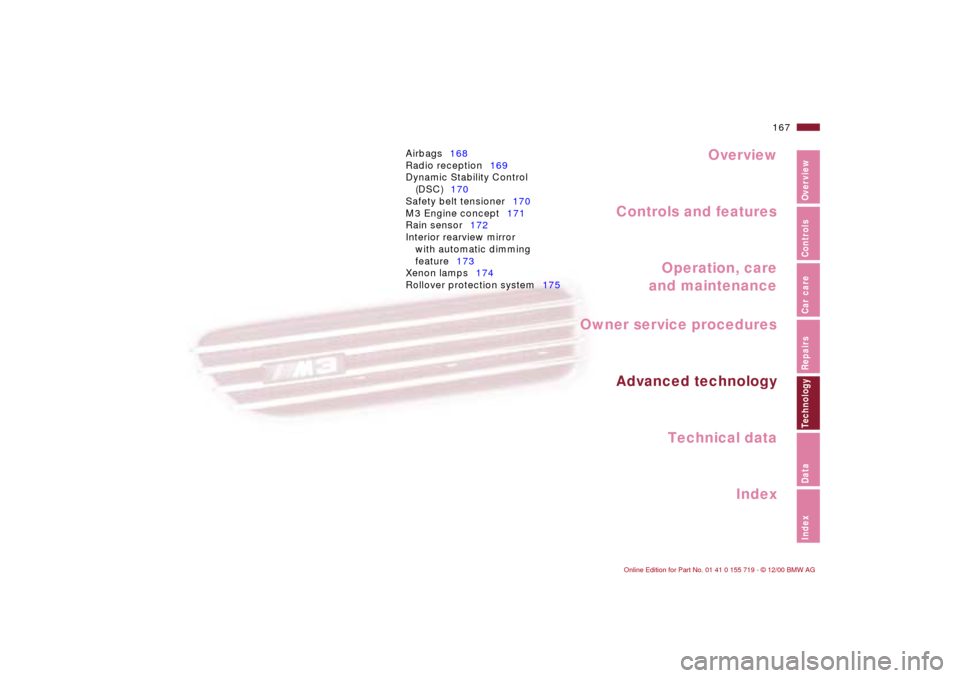
167n
IndexDataTechnologyRepairsCar careControlsOverview
Overview
Controls and features
Operation, care
and maintenance
Technical data
Index Advanced technology
Airbags168
Radio reception169
Dynamic Stability Control
(DSC)170
Safety belt tensioner170
M3 Engine concept171
Rain sensor172
Interior rearview mirror
with automatic dimming
feature173
Xenon lamps174
Rollover protection system175
Tech-
Owner service procedures
Page 168 of 195
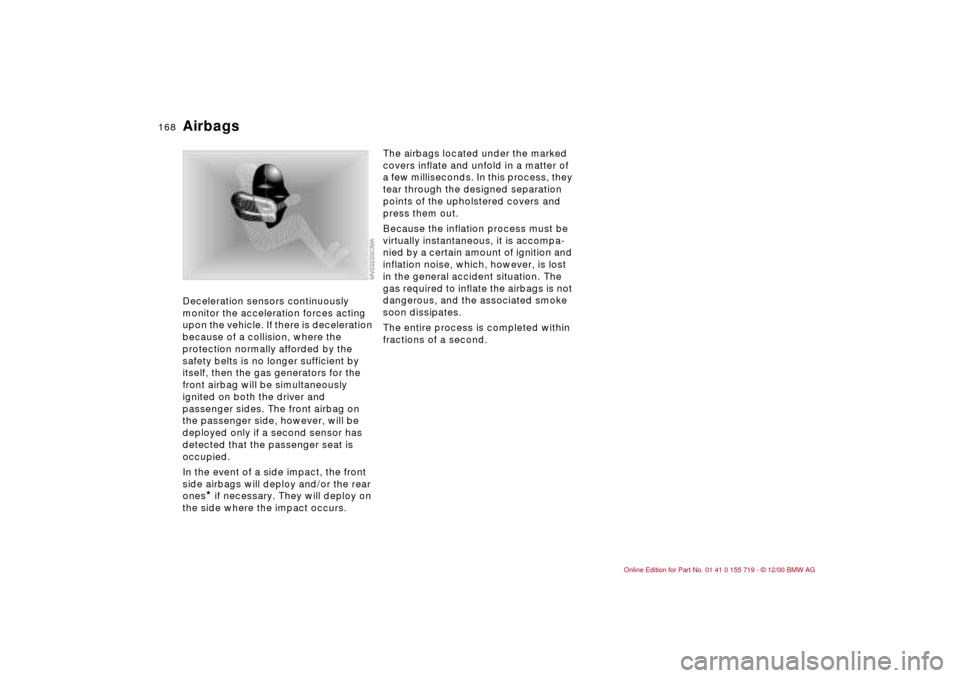
168n
Deceleration sensors continuously
monitor the acceleration forces acting
upon the vehicle. If there is deceleration
because of a collision, where the
protection normally afforded by the
safety belts is no longer sufficient by
itself, then the gas generators for the
front airbag will be simultaneously
ignited on both the driver and
passenger sides. The front airbag on
the passenger side, however, will be
deployed only if a second sensor has
detected that the passenger seat is
occupied.
In the event of a side impact, the front
side airbags will deploy and/or the rear
ones
* if necessary. They will deploy on
the side where the impact occurs.
The airbags located under the marked
covers inflate and unfold in a matter of
a few milliseconds. In this process, they
tear through the designed separation
points of the upholstered covers and
press them out.
Because the inflation process must be
virtually instantaneous, it is accompa-
nied by a certain amount of ignition and
inflation noise, which, however, is lost
in the general accident situation. The
gas required to inflate the airbags is not
dangerous, and the associated smoke
soon dissipates.
The entire process is completed within
fractions of a second.
Airbags
Page 170 of 195

170n
Dynamic Stability Control (DSC) Safety belt tensioner
Highly sensitive sensors monitor the
number of revolutions of the wheels,
steering angle, lateral acceleration,
brake pressure and the movement of
the vehicle around its vertical axis.
If differences in wheel speed should
occur, the system will recognize the
potential dangers associated with
wheel spin and will reduce the drive
torque; if necessary, it will do so using
brake intervention at the rear wheels as
well.
When instable vehicle operating condi-
tions are detected, the application of
the brakes with DSC can also act on the
front wheels to stabilize the vehicle.
You may need some time to become
accustomed to this system's interven-
tion. However, it provides optimum
drive force and vehicle stability.
The braking intervention may be
accompanied by a certain degree of
noise.The safety belt tensioner makes sure
that the belt tightens during a head-on
collision to ensure that occupants
remain firmly positioned in their seats.
A gas-pressure system retracts the
buckle assembly to tension the
shoulder and lap belts within fractions
of a second. This tends to reduce the
tendency to slide under the lap belt
even more.
Page 172 of 195
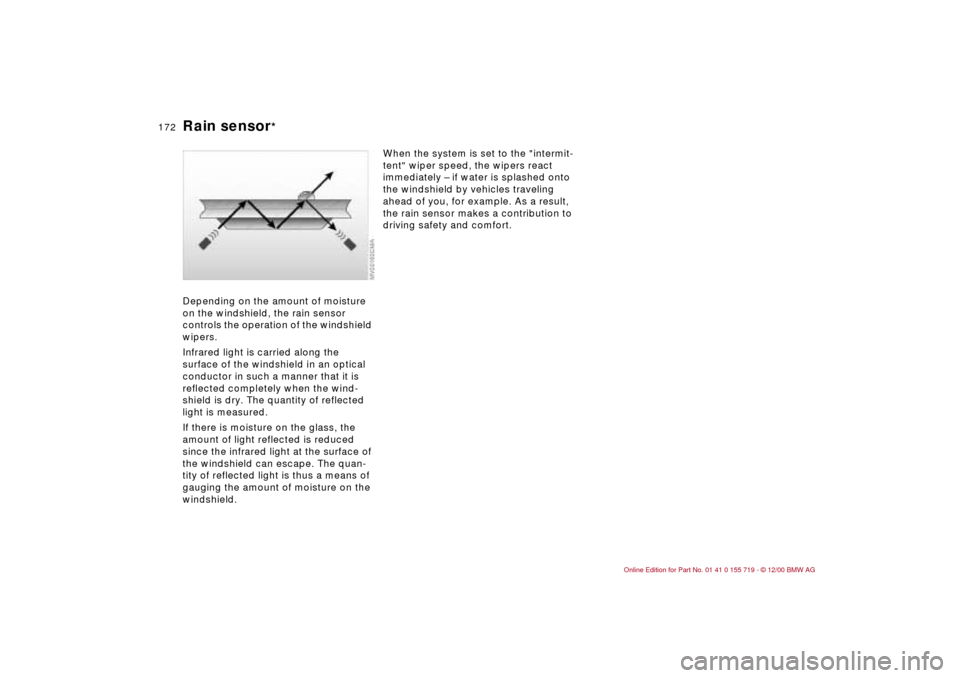
172n
Rain sensor
*
Depending on the amount of moisture
on the windshield, the rain sensor
controls the operation of the windshield
wipers.
Infrared light is carried along the
surface of the windshield in an optical
conductor in such a manner that it is
reflected completely when the wind-
shield is dry. The quantity of reflected
light is measured.
If there is moisture on the glass, the
amount of light reflected is reduced
since the infrared light at the surface of
the windshield can escape. The quan-
tity of reflected light is thus a means of
gauging the amount of moisture on the
windshield.
When the system is set to the "intermit-
tent" wiper speed, the wipers react
immediately – if water is splashed onto
the windshield by vehicles traveling
ahead of you, for example. As a result,
the rain sensor makes a contribution to
driving safety and comfort.
Page 173 of 195
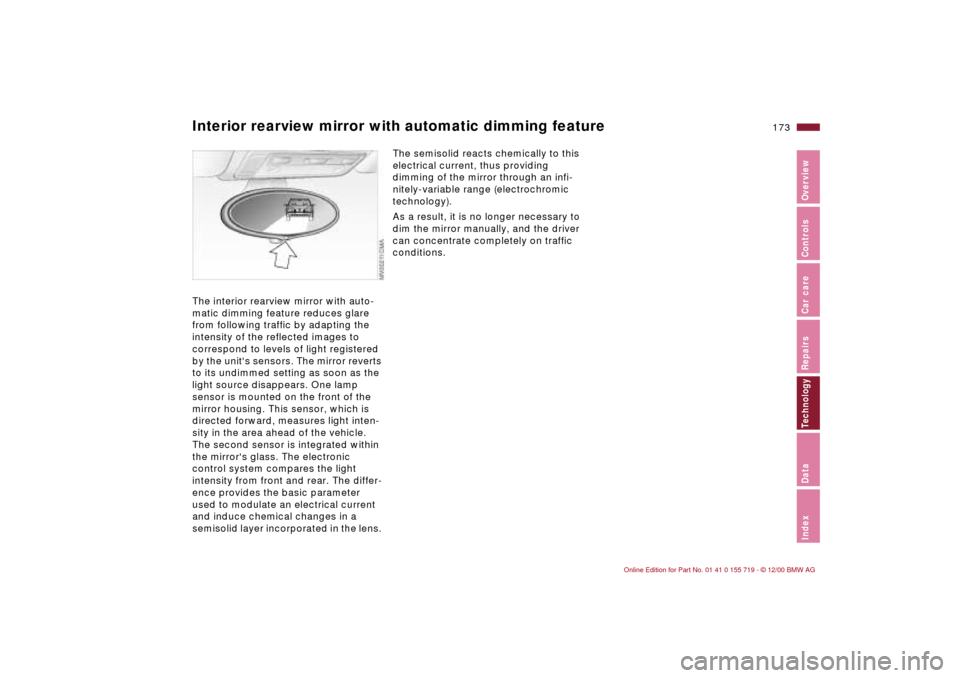
173n
IndexDataTechnologyRepairsCar careControlsOverview
Interior rearview mirror with automatic dimming feature The interior rearview mirror with auto-
matic dimming feature reduces glare
from following traffic by adapting the
intensity of the reflected images to
correspond to levels of light registered
by the unit's sensors. The mirror reverts
to its undimmed setting as soon as the
light source disappears. One lamp
sensor is mounted on the front of the
mirror housing. This sensor, which is
directed forward, measures light inten-
sity in the area ahead of the vehicle.
The second sensor is integrated within
the mirror's glass. The electronic
control system compares the light
intensity from front and rear. The differ-
ence provides the basic parameter
used to modulate an electrical current
and induce chemical changes in a
semisolid layer incorporated in the lens.
The semisolid reacts chemically to this
electrical current, thus providing
dimming of the mirror through an infi-
nitely-variable range (electrochromic
technology).
As a result, it is no longer necessary to
dim the mirror manually, and the driver
can concentrate completely on traffic
conditions.
Page 175 of 195

175n
IndexDataTechnologyRepairsCar careControlsOverview
Rollover protection systemThe rollover protection system offers
protection in addition to the airbags and
the safety belts. It uses highly sensitive
sensors that respond immediately to
any unstable vehicle condition encoun-
tered while driving, e. g. a steep angle
or loss of wheel contact with the
ground. The protective bar in each rear
head restraint is triggered in this type of
situation.
Page 186 of 195
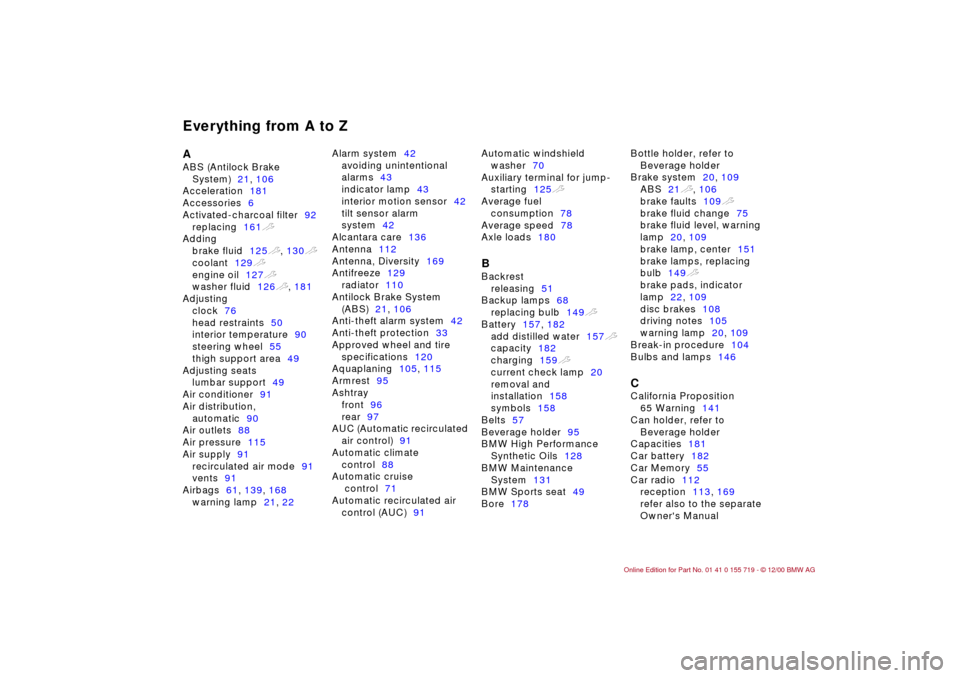
Everything from A to ZAABS (Antilock Brake
System)21, 106
Acceleration181
Accessories6
Activated-charcoal filter92
replacing161t
Adding
brake fluid125t, 130t
coolant129t
engine oil127t
washer fluid126t, 181
Adjusting
clock76
head restraints50
interior temperature90
steering wheel55
thigh support area49
Adjusting seats
lumbar support49
Air conditioner91
Air distribution,
automatic90
Air outlets88
Air pressure115
Air supply91
recirculated air mode91
vents91
Airbags61, 139, 168
warning lamp21, 22Alarm system42
avoiding unintentional
alarms43
indicator lamp43
interior motion sensor42
tilt sensor alarm
system42
Alcantara care136
Antenna112
Antenna, Diversity169
Antifreeze129
radiator110
Antilock Brake System
(ABS)21, 106
Anti-theft alarm system42
Anti-theft protection33
Approved wheel and tire
specifications120
Aquaplaning105, 115
Armrest95
Ashtray
front96
rear97
AUC (Automatic recirculated
air control)91
Automatic climate
control88
Automatic cruise
control71
Automatic recirculated air
control (AUC)91Automatic windshield
washer70
Auxiliary terminal for jump-
starting125t
Average fuel
consumption78
Average speed78
Axle loads180
BBackrest
releasing51
Backup lamps68
replacing bulb149t
Battery157, 182
add distilled water157t
capacity182
charging159t
current check lamp20
removal and
installation158
symbols158
Belts57
Beverage holder95
BMW High Performance
Synthetic Oils128
BMW Maintenance
System131
BMW Sports seat49
Bore178Bottle holder, refer to
Beverage holder
Brake system20, 109
ABS21t, 106
brake faults109t
brake fluid change75
brake fluid level, warning
lamp20, 109
brake lamp, center151
brake lamps, replacing
bulb149t
brake pads, indicator
lamp22, 109
disc brakes108
driving notes105
warning lamp20, 109
Break-in procedure104
Bulbs and lamps146
CCalifornia Proposition
65 Warning141
Can holder, refer to
Beverage holder
Capacities181
Car battery182
Car Memory55
Car radio112
reception113, 169
refer also to the separate
Owner's Manual
Page 187 of 195
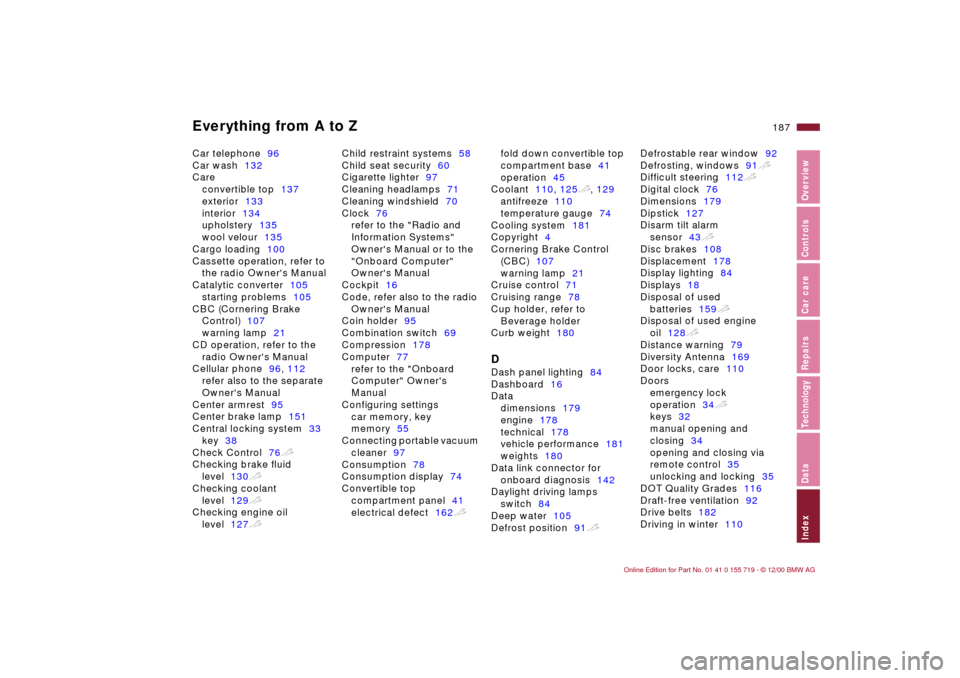
Everything from A to Z
187n
IndexDataTechnologyRepairsCar careControlsOverview
Car telephone96
Car wash132
Care
convertible top137
exterior133
interior134
upholstery135
wool velour135
Cargo loading100
Cassette operation, refer to
the radio Owner's Manual
Catalytic converter105
starting problems105
CBC (Cornering Brake
Control)107
warning lamp21
CD operation, refer to the
radio Owner's Manual
Cellular phone96, 112
refer also to the separate
Owner's Manual
Center armrest95
Center brake lamp151
Central locking system33
key38
Check Control76t
Checking brake fluid
level130t
Checking coolant
level129t
Checking engine oil
level127tChild restraint systems58
Child seat security60
Cigarette lighter97
Cleaning headlamps71
Cleaning windshield70
Clock76
refer to the "Radio and
Information Systems"
Owner's Manual or to the
"Onboard Computer"
Owner's Manual
Cockpit16
Code, refer also to the radio
Owner's Manual
Coin holder95
Combination switch69
Compression178
Computer77
refer to the "Onboard
Computer" Owner's
Manual
Configuring settings
car memory, key
memory55
Connecting portable vacuum
cleaner97
Consumption78
Consumption display74
Convertible top
compartment panel41
electrical defect162tfold down convertible top
compartment base41
operation45
Coolant110, 125t, 129
antifreeze110
temperature gauge74
Cooling system181
Copyright4
Cornering Brake Control
(CBC)107
warning lamp21
Cruise control71
Cruising range78
Cup holder, refer to
Beverage holder
Curb weight180
DDash panel lighting84
Dashboard16
Data
dimensions179
engine178
technical178
vehicle performance181
weights180
Data link connector for
onboard diagnosis142
Daylight driving lamps
switch84
Deep water105
Defrost position91tDefrostable rear window92
Defrosting, windows91t
Difficult steering112t
Digital clock76
Dimensions179
Dipstick127
Disarm tilt alarm
sensor43t
Disc brakes108
Displacement178
Display lighting84
Displays18
Disposal of used
batteries159t
Disposal of used engine
oil128t
Distance warning79
Diversity Antenna169
Door locks, care110
Doors
emergency lock
operation34t
keys32
manual opening and
closing34
opening and closing via
remote control35
unlocking and locking35
DOT Quality Grades116
Draft-free ventilation92
Drive belts182
Driving in winter110